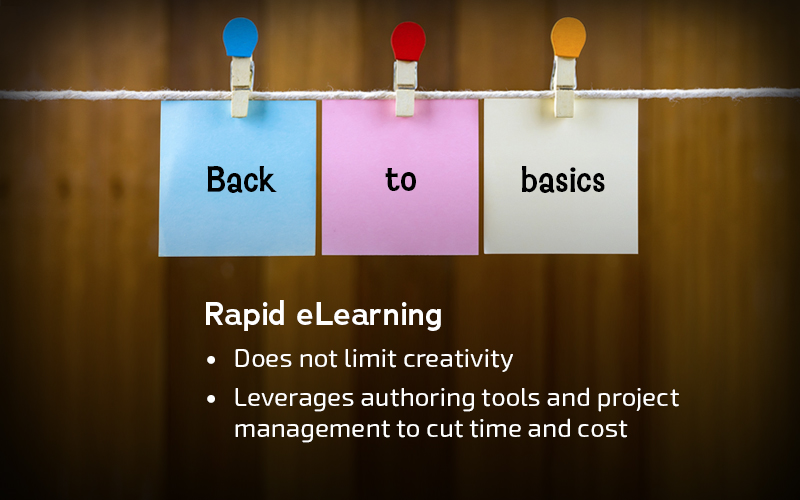5-Point Checklist to Assess Your Readiness for Rapid eLearning

Rapid eLearning has taken the corporate training world by storm, promising faster development times and more engaging experiences.
Is Rapid eLearning the Key to Revolutionizing Your Corporate Training?
Yes. Rapid eLearning excels in corporate training—swift, cost-effective, and flexible. It ensures timely skill acquisition, cost savings, adaptable content, global accessibility, and consistent learning experiences, making it an efficient choice for modern businesses.
Explore What Rapid eLearning is [Watch Video]
But beyond the speed advantage lies a crucial question: can rapid eLearning deliver the depth and rigor required for complex corporate training topics? The answer is a resounding yes, with the right approach and planning.
While speed is a key benefit, rapid eLearning can indeed tackle complex topics. Here's how:
1. Chunking & Microlearning: Break down complex dives into digestible, focused modules to avoid information overload and promote focused learning.
2. Interactive Elements: Incorporate simulations, scenarios, and gamification to reinforce understanding and apply knowledge in a practical context.
3. Performance Support: Provide just-in-time resources like job aids and knowledge bases to complement the training and support ongoing learning.
4. Blended Learning: Combine rapid eLearning with instructor-led sessions or group discussions for deeper exploration and personalized guidance.
Ready to assess your organization's readiness for embracing rapid eLearning for even your most complex training needs? This 5-point checklist will guide you:
5-Point Checklist to Assess Rapid eLearning Readiness
1. Content & Resources
Is your content ready to hit the ground running? Rapid eLearning thrives on easily accessible learning materials. Do you have readily available training documents, existing eLearning modules, or subject matter experts (SMEs) to collaborate with? Their expertise can provide invaluable insights and ensure content accuracy.
Think beyond text: Are your visuals, videos, and audio snippets readily available and adaptable? Easy access to these assets is crucial for quick integration and a visually engaging learning experience. Remember, rapid development doesn't mean compromising quality – having the right resources upfront sets you up for success.
2. Team and Expertise
Don't let skill gaps derail your rapid eLearning plans! Leverage both internal talent and strategic staff augmentation. Does your team have authoring tool ninjas? Fantastic! But consider partnering with eLearning outsourcing experts to fill niche roles like instructional design or animation.

This blended approach optimizes costs, brings fresh perspectives, and accelerates development. Remember, rapid eLearning demands agility – ensure your team, internal or augmented, embraces iterative loops and thrives on fast-paced innovation.
→ Download Now: 4Rs of Rapid eLearning [eBook]
3. Technology and Infrastructure
Rapid eLearning hinges on the right tech stack. Do you have access to user-friendly authoring tools designed for quick content creation? Explore options that prioritize intuitive interfaces and pre-built templates to streamline development.
Seamless integration is key. Ensure your learning management system (LMS) can easily integrate and deliver rapid eLearning modules. Imagine frustrated learners struggling to access training – avoid that by verifying compatibility and smooth deployment within your existing infrastructure.
Think beyond tools. Does your organization have the technical backbone to support rapid deployment and scalability? Consider bandwidth, storage, and accessibility for a seamless implementation. Remember, rapid eLearning is about agility, so ensure your tech infrastructure can keep pace.
4. Learning Design and Measurement
Don't let complexity slow you down! In rapid eLearning, chunking complex topics into clear, achievable objectives is key. Think bite-sized, measurable goals that ensure your modules deliver impactful learning. But don't just shrink the content, adapt your design approach.
Are you familiar with principles of microlearning that promote knowledge retention? Embrace engaging visuals, interactive elements, and spaced repetition to keep learners focused and motivated.
Measurement is your friend. Don't just launch and forget! Have a plan for evaluating the effectiveness of your rapid eLearning programs. Integrate assessment strategies like quizzes, polls, and performance-based tasks to measure impact and identify areas for improvement. Remember, rapid eLearning thrives on iteration – use data insights to continuously refine your modules and ensure they deliver the results you need.

5. Budget and Timelines
Don't let budget woes clip your rapid eLearning wings! Allocate a realistic budget that factors in tool costs, development expenses, and any potential external partnerships. Remember, rapid doesn't mean cheap – consider the value of expertise and quality resources.
Time is of the essence, but not at the expense of quality. Rapid eLearning thrives on shorter development cycles, so ensure your timelines are aligned with this fast-paced approach. Flexibility is key - be prepared to adjust timelines if needed, without sacrificing quality or learner engagement.
Dive into Rapid eLearning: Are You Ready for the Ride?
Forget "one-and-done"! Rapid eLearning thrives on continuous improvement. Be ready to adapt and iterate based on learner feedback and data. Embrace a data-driven, feedback-rich approach to constantly refine your modules and maximize impact. Think of it as an exciting journey, not a fixed destination. Buckle up and enjoy the ride!
Summing Up
So, are you ready to unlock the potential of rapid eLearning for your corporate training? This 5-point checklist will help you assess your organization's readiness, even for complex topics. Remember, the key is leveraging speed without sacrificing depth, engagement, and effective knowledge transfer.
Ready to unlock the potential of rapid eLearning? Dive deeper and get your hands on our free eBook, "4Rs of Rapid eLearning." Inside, you'll discover:
This eBook discusses:
- Redesign – Convert classroom training material to online learning
- Record – Save SME time
- Rebuild – Lengthy courses to microlearning
- Republish – Legacy courses for mobile compatibility





